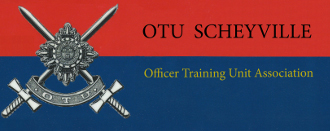Scheyvillians
An updated OTU Structures 1965 to 1973 has been added to the OTU Website (and is attached below).
All are requested to look at their ‘Terms’ and if the ‘Term’ is still in Draft form it means that information is missing.
In other words no-one has provided an OTU General Instruction for that Term.
Please advise The Editor, The Scheyvillian, of such details as:
Your ‘Father’ and ‘Son/s’,
Section Commander/s,
Platoon Sergeant/s,
CHQ Members,
BHQ Members, and
Room Numbers.
If you cannot remember the Room Number, then perhaps you may remember which hut you were in and the relative location of your room. (Please advise)
As a refresher the Hut layout for each Company Structure are shown on the OTU Website under Photo Gallery OTU Cadet Lines.
The Pl Sgts’ room was No. 1, which is on the top left of each hut on the diagrams.
Many ‘Fathers’ and ‘Sons’ were in adjacent rooms.
Every piece of information provided is one more piece of the giant OTU jigsaw!
Neil Leckie
Editor
The Scheyvillian
0400 573 802
Structures attached here:
